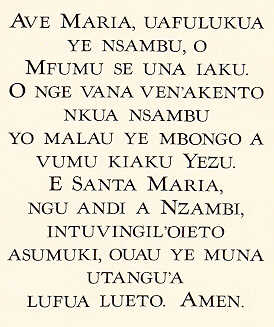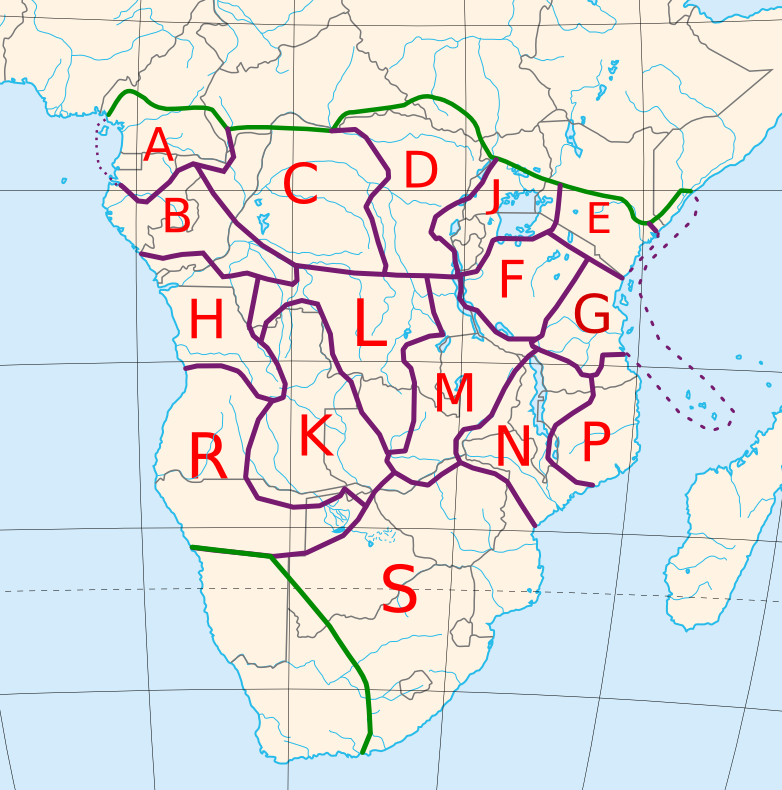|
Angolar Creole
Angolar Creole () is a Portuguese-based creole language of São Tomé and Príncipe, spoken in the southernmost towns of São Tomé Island and sparsely along the coast, especially by Angolar people. It is also called ''n'golá'' by its native speakers. It is a creole language with a majority Portuguese lexicon and a heavy substrate of a dialect of Kimbundu (port. Quimbundo), a Bantu language from inland Angola, where many had come from prior to being enslaved. It is rather different from Sãotomense, the other creole language spoken on the island. Description It is a Portuguese-based creole language different from other Portuguese-based creole languages in Africa. The main difference is the substrate form Kimbundu and Kikongo from Angola. History In the middle of the 16th century, a slave ship from Angola sunk before the southern coast of São Tomé. The surviving people aboard settled the coast as free fishermen. Their language was different from other creole langua ... [...More Info...] [...Related Items...] OR: [Wikipedia] [Google] [Baidu] |
São Tomé And Príncipe
São Tomé and Príncipe, officially the Democratic Republic of São Tomé and Príncipe, is an island country in the Gulf of Guinea, off the western equatorial coast of Central Africa. It consists of two archipelagos around the two main islands of São Tomé and Príncipe, about apart and about off the northwestern coast of Gabon. With a population of 201,800 (2018 official estimate),Instituto Nacional de Estadística de São Tomé e Príncipe, as of 13 May 2018. São Tomé and Príncipe is the second-smallest and second-least populous African sovereign state after Seychelles. The islands were uninhabited until Portuguese explorers João de Santarém and Pedro Escobar became the first Europeans to discover them in 1470. Gradually colonized and settled throughout the 16th century, they collectively served as a vital commercial and trade centre for the Atlantic slave trade. The rich volcanic soil and proximity to the equator made São Tomé and Príncipe ideal for sugar ... [...More Info...] [...Related Items...] OR: [Wikipedia] [Google] [Baidu] |
Sãotomense
Forro Creole () or Sãotomense () is a Portuguese-based creole language spoken in São Tomé and Príncipe. It should not be confused with São Tomean Portuguese, the non-creolised form of Portuguese spoken in São Tomé and Príncipe by the majority of São Toméans. History São Tomé is an island of the Gulf of Guinea, discovered by the Portuguese in the 15th century. It was uninhabited at the time, but Portuguese settlers used the island as a center of the slave trade, and there was a need for slaves on the island. It has been theorised that since both parties needed to communicate, a pidgin was formed. The substrate languages were from the Bantu and Kwa groups. It is believed that this pidgin then became fixed ( creolized) as it became the mother language of children born from Portuguese men and African women slaves. Mixed marriages were then encouraged by the Portuguese Crown, for the sake of settlement. Later, because of Dutch and French pressure to gain the isl ... [...More Info...] [...Related Items...] OR: [Wikipedia] [Google] [Baidu] |
Code Switching
In linguistics, code-switching or language alternation occurs when a speaker alternates between two or more languages, or language varieties, in the context of a single conversation or situation. These alternations are generally intended to influence the relationship between the speakers, for example, suggesting that they may share identities based on similar linguistic histories. Code-switching is different from plurilingualism in that plurilingualism refers to the ability of an individual to use multiple languages, while code-switching is the act of using multiple languages together. Multilinguals (speakers of more than one language) sometimes use elements of multiple languages when conversing with each other. Thus, code-switching is the use of more than one linguistic variety in a manner consistent with the syntax and phonology of each variety. Code-switching may happen between sentences, sentence fragments, words, or individual morphemes (in synthetic languages). Howev ... [...More Info...] [...Related Items...] OR: [Wikipedia] [Google] [Baidu] |
Vernacular Language
Vernacular is the ordinary, informal, spoken form of language, particularly when perceived as having lower social status or less prestige than standard language, which is more codified, institutionally promoted, literary, or formal. More narrowly, a particular language variety that does not hold a widespread high-status perception, and sometimes even carries social stigma, is also called a vernacular, vernacular dialect, nonstandard dialect, etc. and is typically its speakers' native variety. Regardless of any such stigma, all nonstandard dialects are full-fledged varieties of language with their own consistent grammatical structure, sound system, body of vocabulary, etc. Overview Like any native language variety, a vernacular has an internally coherent system of grammar. It may be associated with a particular set of vocabulary, and spoken using a variety of accents, styles, and registers. As American linguist John McWhorter describes about a number of dialects spo ... [...More Info...] [...Related Items...] OR: [Wikipedia] [Google] [Baidu] |
Slave Ship
Slave ships were large cargo ships specially built or converted from the 17th to the 19th century for transporting Slavery, slaves. Such ships were also known as "Guineamen" because the trade involved human trafficking to and from the Guinea (region), Guinea coast in West Africa. Atlantic slave trade In the early 17th century, more than a century after the arrival of European emigration, Europeans to the Americas, demand for unpaid labor to work plantations made slave-trading a profitable business. The Atlantic slave trade peaked in the last two decades of the 18th century, during and following the Kongo Civil War. To ensure Profit (accounting), profitability, the owners of the ships divided their Hull (watercraft), hulls into holds with little headroom, so they could transport as many slaves as possible. Unhygienic conditions, dehydration, dysentery, and scurvy led to a high mortality rate, on average 15% and up to a third of captives. Often, the ships carried hundreds of sla ... [...More Info...] [...Related Items...] OR: [Wikipedia] [Google] [Baidu] |
Kongo Language
Kongo or Kikongo is one of the Bantu languages spoken by the Kongo people living in the Democratic Republic of the Congo (DRC), the Republic of the Congo, Gabon, and Angola. It is a tonal language. The vast majority of present-day speakers live in Africa. There are roughly seven million native speakers of Kongo in the above-named countries. An estimated five million more speakers use it as a second language. Historically, it was spoken by many of those Africans who for centuries were taken captive, transported across the Atlantic, and sold as slaves in the Americas. For this reason, creolized forms of the language are found in ritual speech of Afro-American religions, especially in Brazil, Cuba, Puerto Rico, Dominican Republic, Haiti, and Suriname. It is also one of the sources of the Gullah language, which formed in the Low Country and Sea Islands of the United States Southeast. The Palenquero creole in Colombia is also related to Kong creole. Geographic distribution Kongo wa ... [...More Info...] [...Related Items...] OR: [Wikipedia] [Google] [Baidu] |
Kimbundu
Kimbundu, a Bantu language which has sometimes been called Mbundu or North Mbundu (to distinguish it from Umbundu, sometimes called South Mbundu), is the second-most-widely-spoken Bantu language in Angola. Its speakers are concentrated in the north-west of the country, notably in the Luanda, Bengo, Malanje and the Cuanza Norte provinces. It is spoken by the Ambundu. Phonology Consonants Allophones: �and �are allophones of /p/ and /b/, respectively, before /a/ and /u/. The phoneme /l/ is phonetically a flap � a voiced plosive or its palatalized version ʲwhen before the front high vowel /i/. In the same way, the alveolars /s/, /z/ and /n/ are palatalized to � �and � respectively, before There may be an epenthesis of after /ŋ/ in word medial positions, thus creating a phonetic cluster �gin a process of fortition. There is long distance nasal harmony, in which /l/ is realized as if the previous morphemes contain /m/ or /n/, but not prenasalized stops. Vo ... [...More Info...] [...Related Items...] OR: [Wikipedia] [Google] [Baidu] |
Angola
Angola, officially the Republic of Angola, is a country on the west-Central Africa, central coast of Southern Africa. It is the second-largest Portuguese-speaking world, Portuguese-speaking (Lusophone) country in both total area and List of countries and dependencies by population, population and is the List of African countries by area, seventh-largest country in Africa. It is bordered by Namibia to the south, the Democratic Republic of the Congo to the north, Zambia to the east, and the Atlantic Ocean to the west. Angola has an Enclave and exclave, exclave province, the province of Cabinda Province, Cabinda, that borders the Republic of the Congo and the Democratic Republic of the Congo. The capital and most populous city is Luanda. Angola has been inhabited since the Paleolithic, Paleolithic Age. After the Bantu expansion reached the region, states were formed by the 13th century and organised into confederations. The Kingdom of Kongo ascended to achieve hegemony among the ... [...More Info...] [...Related Items...] OR: [Wikipedia] [Google] [Baidu] |
Portuguese-based Creole
Portuguese creoles () are creole languages which have Portuguese as their substantial lexifier. The most widely-spoken creoles influenced by Portuguese are Cape Verdean Creole, Guinea-Bissau Creole and Papiamento. Origins Portuguese overseas exploration in the 15th and 16th centuries led to the establishment of a Portuguese Empire with trading posts, forts and colonies in Africa, Asia and the Americas. Contact between the Portuguese language and native languages gave rise to many Portuguese-based pidgins, used as linguas francas throughout the Portuguese sphere of influence. In time, many of these pidgins were nativized, becoming new stable creole languages. As is the rule in most creoles, the lexicon of these languages can be traced to the parent languages, usually with predominance of Portuguese; These creoles are (or were) spoken mostly by communities of descendants of Portuguese, natives, and sometimes other peoples from the Portuguese colonial empire. Until recent ... [...More Info...] [...Related Items...] OR: [Wikipedia] [Google] [Baidu] |
Bantu Language
The Bantu languages (English: , Proto-Bantu language, Proto-Bantu: *bantʊ̀), or Ntu languages are a language family of about 600 languages of Central Africa, Central, Southern Africa, Southern, East Africa, Eastern and Southeast Africa, Southeast Africa. They form the largest branch of the Southern Bantoid languages. The total number of Bantu languages is estimated at between 440 and 680 distinct languages, depending on the definition of Dialect#Dialect or language, "language" versus "dialect"."Guthrie (1967–71) names some 440 Bantu 'varieties', Grimes (2000) has 501 (minus a few 'extinct' or 'almost extinct'), Bastin ''et al.'' (1999) have 542, Maho (this volume) has some 660, and Mann ''et al.'' (1987) have ''c.'' 680." Derek Nurse, 2006, "Bantu Languages", in the ''Encyclopedia of Language and Linguistics'', p. 2:Ethnologue report for Southern Bantoid" lists a total of 535 languages. The count includes 13 Mbam languages, which are not always included under "Narrow Bantu". ... [...More Info...] [...Related Items...] OR: [Wikipedia] [Google] [Baidu] |
Kimbundu Language
Kimbundu, a Bantu language which has sometimes been called Mbundu or North Mbundu (to distinguish it from Umbundu, sometimes called South Mbundu), is the second-most-widely-spoken Bantu language in Angola. Its speakers are concentrated in the north-west of the country, notably in the Luanda, Bengo, Malanje and the Cuanza Norte provinces. It is spoken by the Ambundu. Phonology Consonants Allophones: �and �are allophones of /p/ and /b/, respectively, before /a/ and /u/. The phoneme /l/ is phonetically a flap � a voiced plosive or its palatalized version ʲwhen before the front high vowel /i/. In the same way, the alveolars /s/, /z/ and /n/ are palatalized to � �and � respectively, before There may be an epenthesis of after /ŋ/ in word medial positions, thus creating a phonetic cluster �gin a process of fortition. There is long distance nasal harmony, in which /l/ is realized as if the previous morphemes contain /m/ or /n/, but not prenasalized stops. Vowe ... [...More Info...] [...Related Items...] OR: [Wikipedia] [Google] [Baidu] |




